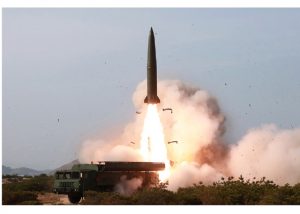False Analogies: North Korea’s History of Missile Test Moratoria

At times like this, it never hurts to get at least some of the history straight.
Despite a growing narrative in the media, North Korea’s launch of a “tactical guided weapon” on May 4 has no real parallels to what happened when Pyongyang ended the Clinton-era missile launch moratorium. That moratorium ended with a formal declaration—a Foreign Ministry memo—in March 2005 that the DPRK was no longer bound by its 1999 unilaterally proclaimed moratorium on the grounds that its original action would only continue as long as US-DPRK dialogue was under way. The 1999 moratorium, announced after US-DPRK talks in Berlin in September, was the product of negotiations resulting from former Defense Secretary William Perry’s suggestion that each side take a unilateral step to create a better atmosphere for talks building on the Agreed Framework.
The North may not consider it is now operating under a new “moratorium,” unilateral or otherwise. In April 2018—before the summits with either ROK President Moon or US President Trump—Pyongyang announced the end (not a moratorium but the end) of nuclear and long-range missile tests. This step was tightly bound to a major change in strategy announced at a party plenary session—i.e., the “new strategic line” mandating “everything for the economy.” The decision to stop nuclear and long-range missile tests, premised on the claim that the North had “completed” its nuclear force, was presented without conditions.
To end the 1999 moratorium was, in effect, as easy as falling off a log. After taking over in January 2001, the Bush administration had not picked up DPRK offers on the table to discuss the missile issue, and in October 2002, the administration effectively ended the Agreed Framework. By contrast, reversing the plenum decision announced in April 2018 would require a major and wrenching strategic line change, involving not simply military and diplomatic issues but also the core of economic policy. That could still be done but is unlikely to be undertaken only two months after the Hanoi Summit. If there is a decision to move in that direction, it is more likely to be part of the planning involved with Kim’s warning in his April 12 speech to the Supreme People’s Assembly that the US has until the end of the year to make a major change in its approach to the North. That warning has since been underlined in recent Foreign Ministry pronouncements, including one by First Vice Foreign Minister Choe Son Hui that, “We are well aware of the road we are to follow but we are merely holding back our decision because we have provided the time frame for the U.S.”
